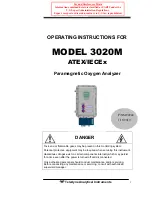
49
O&M Manual
Rev-J (11/18)
Part 7 – Calibration
7.1
Chlorine Dioxide Calibration
After power is applied, the sensor must be given time to stabilize. This is best done by following
the zeroing procedure below. Establishing a stable zero is important to the proper operation of
the monitor. A complete calibration will include zeroing and spanning the sensor. It is generally
unnecessary to set the sensor zero unless the monitor will be used primarily for measurements
below 0.5 PPM. Typical sensor zero offsets are less than 0.01 PPM and can largely be ignored
in many applications.
7.11 ClO
2
Zero Cal
ClO
2
sensors have extremely low offset currents at zero.
For this reason, it is normally
sufficient to simply leave the zero at the factory default of 0.0 nA
. As an alternative, an
electronic zero can be set by disconnecting the sensor from the cable and performing steps 3-5
below.
If sensor zeroing is desired, the steps below will guide you through the process. This procedure
assumes that the sensor has been prepared in accordance with section 5.1, ClO
2
Sensor
Assembly, earlier in this manual. Note that the 8 hour waiting time in step 2 below is not required
if the monitor has been running for 24 hours prior to zeroing. If the unit has been running with the
sensor connected, the sensor will normally return to a stable zero within 15 minutes.
1. Connect the sensor to the electronics by plugging the cable plug into the receptacle on the
top of the sensor.
2. Place about an inch of water in a small beaker or other convenient container and immerse
the tip of the sensor. The water used need not be distilled, but it must not contain chlorine
dioxide. For submersible sensors, submerge the entire sensor in a bucket of non-ozonated
water. Allow the sensor to sit undisturbed for at least 15-30 minutes.
3. Scroll to the CAL menu section using the MENU key and press ENTER or the UP arrow key.
Cal
ClO
2
will then be displayed.
4.
Press the ENTER key. The screen will display a flashing
1-Ref
for span calibration or a
2-
Zer
for zero calibration. Using the UP arrow key, set for a
2-Zer
zero calibration and press
ENTER.
5. The system now begins acquiring data for the sensor zero calibration value. As data is
gathered, the units for sensor current in nanoamps (nA) and temperature may flash. Flashing
units indicate that this parameter is unstable. The calibration data point acquisition will stop
only when the data remains stable for a pre-determined amount of time. This can be
overridden by pressing ENTER. If the data remains unstable for 10 minutes, the calibration
will fail and the message
CalUnstable
will be displayed.
6. If accepted, the screen will display the message
PASS
with the new sensor zero reading
(offset), then it will return to the main measurement display. If the calibration fails, a message
indicating the cause of the failure will be displayed and the FAIL icon will be turned on. The
range of acceptable value for sensor offset is -25 nA to +25 nA. Should a FAIL occur,
















































